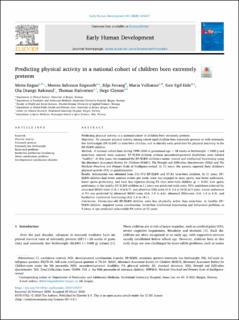Predicting physical activity in a national cohort of children born extremely preterm
Engan, Mette; Engeseth, Merete Salveson; Fevang, Silje Katrine Elgen; Vollsæter, Maria; Eide, Geir Egil; Røksund, Ola Drange; Halvorsen, Thomas; Clemm, Hege Havstad
Peer reviewed, Journal article
Published version

Permanent lenke
https://hdl.handle.net/11250/2734584Utgivelsesdato
2020Metadata
Vis full innførselSamlinger
- Artikler / Articles [2096]
- Publikasjoner fra Cristin [1084]
Originalversjon
Early Human Development. 2020, 145, Artikkel 105037. 10.1016/j.earlhumdev.2020.105037Sammendrag
Objectives: To compare physical activity among school-aged children born extremely preterm or with extremely low birthweight (EP/ELBW) to term-born children, and to identify early predictors for physical inactivity in the EP/ELBW-children.
Methods: A national cohort born during 1999–2000 at gestational age < 28 weeks or birthweight <1000 g and term-born controls were assessed. EP/ELBW-children without neurodevelopmental disabilities were labeled “healthy”. At five years, we examined the EP/ELBW-children's motor, mental and intellectual functioning using the Movement Assessment Battery for Children (MABC), The Strength and Difficulties Questionnaire (SDQ) and The Wechsler Preschool and Primary Scale of Intelligence-revised. At 11 years, the parents reported their children's physical activity (PA) in questionnaires.
Results: Information was obtained from 231/372 EP/ELBW and 57/61 term-born children. At 11 years, EP/ELBW-children had fewer exercise events per week, were less engaged in team sports, had lower endurance, lower sports proficiency, and were less vigorous during PA than term-born children (p < 0.05). Low sports proficiency in the healthy EP/ELBW-children at 11 years was predicted (odds ratio; 95% confidence interval) by abnormal MABC-score (3.0; 1.0 to 8.7), and abnormal SDQ-score (4.0; 1.6 to 10.0) at 5 years. Lower endurance at PA was predicted by abnormal MABC-score (2.6; 1.0 to 6.6), abnormal SDQ-score (3.0; 1.4 to 6.5), and borderline intellectual functioning (4.2; 1.8 to 10.1).
Conclusions: Eleven-year-old EP/ELBW-children were less physically active than term-born. In healthy EP/ELBW-children, impaired motor coordination, borderline intellectual functioning and behavioral problems at 5 years of age predicted unfavorable PA habits at 11 years.
Beskrivelse
This is an open access article under the CC BY license (http://creativecommons.org/licenses/BY/4.0/).